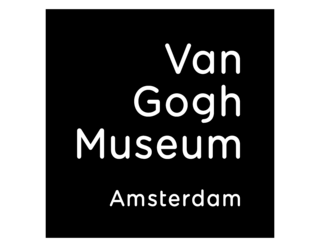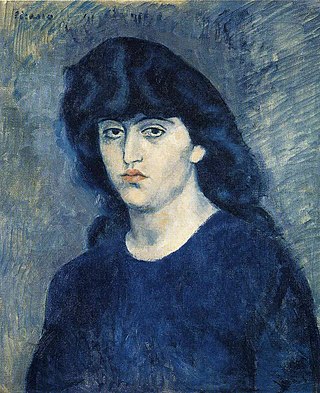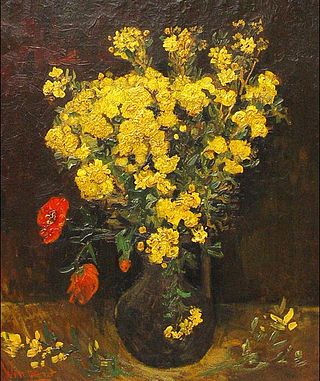Related Research Articles

The Van Gogh Museum is a Dutch art museum dedicated to the works of Vincent van Gogh and his contemporaries in the Museum Square in Amsterdam South, close to the Stedelijk Museum, the Rijksmuseum, and the Concertgebouw. The museum opened on 2 June 1973, and its buildings were designed by Gerrit Rietveld and Kisho Kurokawa.

Art theft, sometimes called artnapping, is the stealing of paintings, sculptures, or other forms of visual art from galleries, museums or other public and private locations. Stolen art is often resold or used by criminals as collateral to secure loans. Only a small percentage of stolen art is recovered—an estimated 10%. Many nations operate police squads to investigate art theft and illegal trade in stolen art and antiquities.

The Potato Eaters is an oil painting by Dutch artist Vincent van Gogh painted in April 1885 in Nuenen, Netherlands.

Wheatfield with Crows is a July 1890 painting by Vincent van Gogh. It has been cited by several critics as one of his greatest works.

The Foundation E. G. Bührle Collection is an art museum in Zürich, Switzerland. It was established by the Bührle family to make Emil Georg Bührle's collection of European sculptures and paintings available to the public. The museum is in a villa adjoining Bührle's former home. In 2021 many works were exhibited on 20-year loan in almost a whole floor of the new extension of the Kunsthaus Zürich museum. There was controversy due to suspicions that many works were looted from Jews by Nazi Germany. The foundation was managed for decades by Bührle's son Dieter, who was sentenced to a conditional prison term of 8 months in 1970 for supplying weapons to the racist apartheid regime in South Africa.
The fame of Vincent van Gogh began to spread in France and Belgium during the last year of his life, and in the years after his death in the Netherlands and Germany. His friendship with his younger brother Theo was documented in numerous letters they exchanged from August 1872 onwards. The letters were published in three volumes in 1914 by Johanna van Gogh-Bonger, Theo's widow, who also generously supported most of the early Van Gogh exhibitions with loans from the artist's estate. Publication of the letters helped spread the compelling mystique of Vincent van Gogh, the intense and dedicated painter who died young, throughout Europe and the rest of the world.

Portrait of Suzanne Bloch is an oil on canvas painting executed by the Spanish artist Pablo Picasso in Paris in 1904, towards the end of his Blue Period. The subject, Suzanne Bloch, was a singer known for her Wagner interpretations, and the sister of the violinist Henri Bloch. The painting is housed in the São Paulo Museum of Art.

Congregation Leaving the Reformed Church at Nuenen is an early painting by Vincent van Gogh, made in early 1884 and modified in late 1885. It is displayed at the Van Gogh Museum in Amsterdam.

Poppy Flowers is a painting by Vincent van Gogh with an estimated value of US$55 million which was stolen from Cairo's Mohamed Mahmoud Khalil Museum twice; first in 1977, then again in August 2010 and has yet to be found.

Singer Laren is a museum and concert hall located in the center of Laren, the Netherlands. The museum is devoted to presenting and preserving the collection of the American artist William Henry Singer (1868–1943) and his wife Anna (1878–1962).

The Parsonage Garden at Nuenen, alternatively named The Parsonage Garden at Nuenen in Spring or Spring Garden, is an early oil painting by 19th-century Dutch post-Impressionist painter Vincent van Gogh, created in May 1884 while he was living with his parents in Nuenen. Van Gogh made several drawings and oil paintings of the surrounding gardens and the garden façade of the parsonage.

Beach at Scheveningen in Stormy Weather, also known as View of the Sea at Scheveningen, is an early oil painting by Vincent van Gogh, painted at Scheveningen near The Hague in August 1882. It is held in the Van Gogh Museum in Amsterdam.

Two Laughing Boys with a Mug of Beer is an oil-on-canvas painting by Frans Hals, created c. 1626, showing a Kannekijker (mug-looker). It hangs in the Hofje van Mevrouw van Aerden museum in Leerdam, Netherlands. It was stolen from the museum in 2020 and is still missing.

Still Life with Candlestick is an oil painting created in 1922 by the French artist Fernand Léger.

The Diggers or Two Diggers is an oil painting by Dutch artist Vincent van Gogh painted in late 1889 in Saint-Rémy-de-Provence, France. It is in the Detroit Institute of Arts (DIA), Detroit, Michigan, United States. The Diggers is sometimes called Two Diggers among Trees to distinguish it from The Diggers , 1889.

Prisoners' Round , also known as The Prisoners' Round, or Prisoners Exercising, or Penitentiary , (F669) is an oil painting of February 1890 by Vincent van Gogh. This late work was painted at Saint-Paul Asylum in Saint-Rémy, inspired by an 1872 engraving by Gustave Doré of the exercise yard at Newgate Prison. The original oil painting is held by the Pushkin Museum in Moscow.

Many priceless artworks by the Dutch post-impressionist artist Vincent van Gogh were looted by Nazis during 1933–1945, mostly from Jewish collectors forced into exile or murdered.
References
- ↑ Boztas, Senay (25 September 2023). "Arthur Brand: 'I never give up informants - they will shoot you dead'". The Guardian. Retrieved 18 October 2023.
- 1 2 Siegal, Nina (15 December 2015). "Stolen Dutch Art Shows Up in Ukraine, but Getting It Back Isn't Easy". New York Times . Retrieved 2018-11-19.
The museum hired Arthur Brand, a Dutch art crime investigator, to go to Ukraine to negotiate with the militia, the Battalion of the Organization of Ukrainian Nationalists.
- ↑ "Dutch paintings retrieved from the black market after more than a decade". CNN Style. 2016-10-05. Retrieved 2018-11-19.
- ↑ "The 'Indiana Jones of the Art World' Has Found a $28 Million Picasso Stolen From a Saudi Prince's Yacht Two Decades Ago". Artnet News. 2019-03-26. Retrieved 2021-02-13.
- 1 2 3 Jones, Ralph. "Meet the world's greatest art detective". www.bbc.com. Retrieved 2021-02-13.
- ↑ "Confessions of an art detective: Arthur Brand". The Gentleman's Journal. Retrieved 2021-02-13.
- ↑ "Missing 1,600-year-old mosaic returned after four decades". CNN Style. 2018-11-19. Retrieved 2018-11-19.
- ↑ "Investigator "100 percent sure" stolen art from legendary heist is in Ireland". CBS News . 12 July 2017. Retrieved 19 November 2018.
He's described as the Indiana Jones of the art world
- ↑ "How an art detective recovered two stolen multi-million pound paintings". The Independent. 2016-08-03. Retrieved 2019-01-16.
- ↑ "'Handed over in an Ikea bag': art detective recovers Van Gogh painting stolen from Dutch museum". The Art Newspaper. 2023-09-12. Retrieved 2023-09-12.
- ↑ "Dutch art sleuth recovers a further six stolen paintings". The Guardian. 17 October 2023. Retrieved 18 October 2023.
- ↑ "Boeken". Arthur Brand (in Dutch). Retrieved 2020-10-09.
- ↑ "De Kunstdetective". MAX Vandaag (in Dutch). Retrieved 18 October 2023.
- ↑ "De kunstdetective". Boekerij (in Dutch). 28 June 2021. Retrieved 18 October 2023.